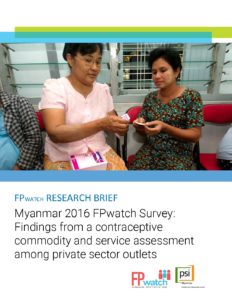Abstract
FAMILY PLANNING ENVIRONMENT IN MYANMAR
Myanmar has made steady and important gains in availability of and access to modern contraceptive methods in recent years. The modern contraceptive prevalence rate (mCPR) has increased from 32.8% in 2001 to 51.3% in 2015. 1,2 However, unmet need for modern family planning methods remains higher than national goals at 16.3% and regional disparities and inequities in access between urban and rural and rich and poor populations persist.3
The most common modern family planning methods reportedly used in Myanmar are contraceptive injections and oral contraceptives, used by 27.6% and 13.8% of currently married women, respectively. Less than 9% of currently married women use long-acting reversible contraceptives or permanent methods (LARC/PMs). There is an ongoing opportunity to increase contraceptive access for women of reproductive age, which make up 30% of Myanmar’s population.4
SECTOR ROLES IN CONTRACEPTIVE PROVISION
Family planning services and commodities provided through the public sector are augmented by private for profit and not-for-profit providers, especially clinics and pharmacies. In addition, there are a large number of trained health workers acting in a private capacity, as well as general retailers and untrained providers known to be providing family planning commodities and services. A small majority of modern family planning methods are provided by the private sector (51.8%) compared to the public sector (42.2%), but the large majority of LARC/PMs are provided by the public sector.
From 2014-15, the Myanmar government completed a health facility survey looking at the availability of family planning and reproductive health commodities in the public sector. However, high quality evidence related to the private sector provision of modern family planning methods remains limited.



